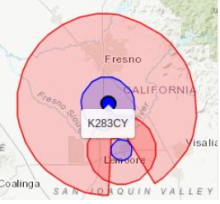Bustos Media LLC from Portland, Oregon is the archetype of a commercial minority broadcaster success story. Amador Bustos immigrated to the United States, received degrees from UC Berkeley, served on the Redwood City School board, and formed Bustos Media in Sacramento, California in the early 2000’s. After a first network of stations was sold off, another chain of Spanish-language stations was established in Washington and Oregon headquartered in Portland. The outfit also runs two Russian-language format under local management agreements. Bustos carving out a market for minority-run commercial outfit for foreign-language programming is a laudable endeavor.
Broadcasting at the core, however, is a business. Bustos owns several AM stations, especially in Portland. Portland is known for its community activism, and when it comes to LPFM it is no different. The recent FCC cross-service FM translator application filing window gave AM licensees the opportunity to apply for FM channels to rebroadcast AM stations on FM channels. Most urbanized areas are tight for un-utilized spectrum; Portland is no exception.
Bustos first applied for 101.5 FM, attempting to wedge a 2-watt directional antenna translator into a low population area in the Portland metro in between two LPFM stations that also shared the same channel, both in Portland. Such a move is seen as a prospective measure-- apply for the smallest channel possible, upgrade the channel’s power once it has been operating on the air for a while (when it is much more difficult to contest). Since LPFM channels depend on fringe coverage to be sustainable at a maximum coverage of 100 watts with antenna at 30 meters, the interference to LPFM coverage renders the LPFM unsustainable. The hope for the commercial broadcaster is the LPFM will go off the air at that point. At that point, the translator has free reign to take fourth-fifths of the frequency within the urban area, slicing-out a corner for the remaining LPFM. This is informally referred to as a “pac man” scenario in LPFM-advocate circles, as the translator looks like it is eating the LPFM.


Bustos also applied for 99.9 FM, home of KXRW-LP, Vancouver, WA, which signal also penetrates into Portland. A directional antenna was also employed here. KXRW-LP filed a Petition for Reconsideration against the proposal, citing many listeners would receive interference to KXRW-LP’s off-the-air signal. In a perplexing case, the FCC denied KXRW-LP’s case because it utilized Longley-Rice propagation instead of FCC contours to demonstrate interference, while previously the Commission had accepted Longley-Rice in previous cases. The verdict was appealed.
Bustos went onto apply for two other translators in Portland that were also occupied by LPFM broadcasters--95.1 FM and 105.5 FM. It attempted to obfuscate the LPFM stations on those channels by selecting the first adjacent channels, 94.9 FM and 105.7 FM within the short form applications, which obviously did not meet interference requirements, and then changed the frequencies to the first adjacent channels on the long form application. Both KISN-LP 95.1 FM and KXRU-LP 105.5 obtained legal representation to demonstrate that their listeners were affected. The outcome was the 105.5 FM translator proposal was a modification to jump to 100.7 FM after the new rulemaking was passed by the FCC to allow translators to relocate to any open channels on the FM band in cases of interference. This spawned another LPFM problem -- the proposed 100.7 FM translator was wedged in between another two Portland metro LPFM stations -- KQRZ-LP Beaverton, and KBSF-LP Portland. The hope in these situations for the commercial broadcaster is that the Low Power stations do not have the money to hire legal representation to defend their coverage. KQRZ-LP appears to have filed a contest, demonstrating that they do have listeners which may be impacted by the addition of the translator channel move to 100.7 FM. Often at times, an LPFM’s fringe signal may have a hard time defending against the newly proposed translator because the LPFM signal may not make it to the “60 dBu FCC coverage area” of the translator. This is a requirement to contest a translator. The translator might merely be “short spacing” the LPFM -- in other words, making it impossible for the LPFM to move, expand, or upgrade in the direction of the translator.
Bustos has also been within contest regarding a new translator that encroaches upon K266BM, owned by Olympia-independent broadcaster Northwest Rocknroll Preservation Society, which has historically been associated with non-commercial operation.
With the dearth of FM spectrum on the dial, it is likely these types of contests are commonplace in the future.
